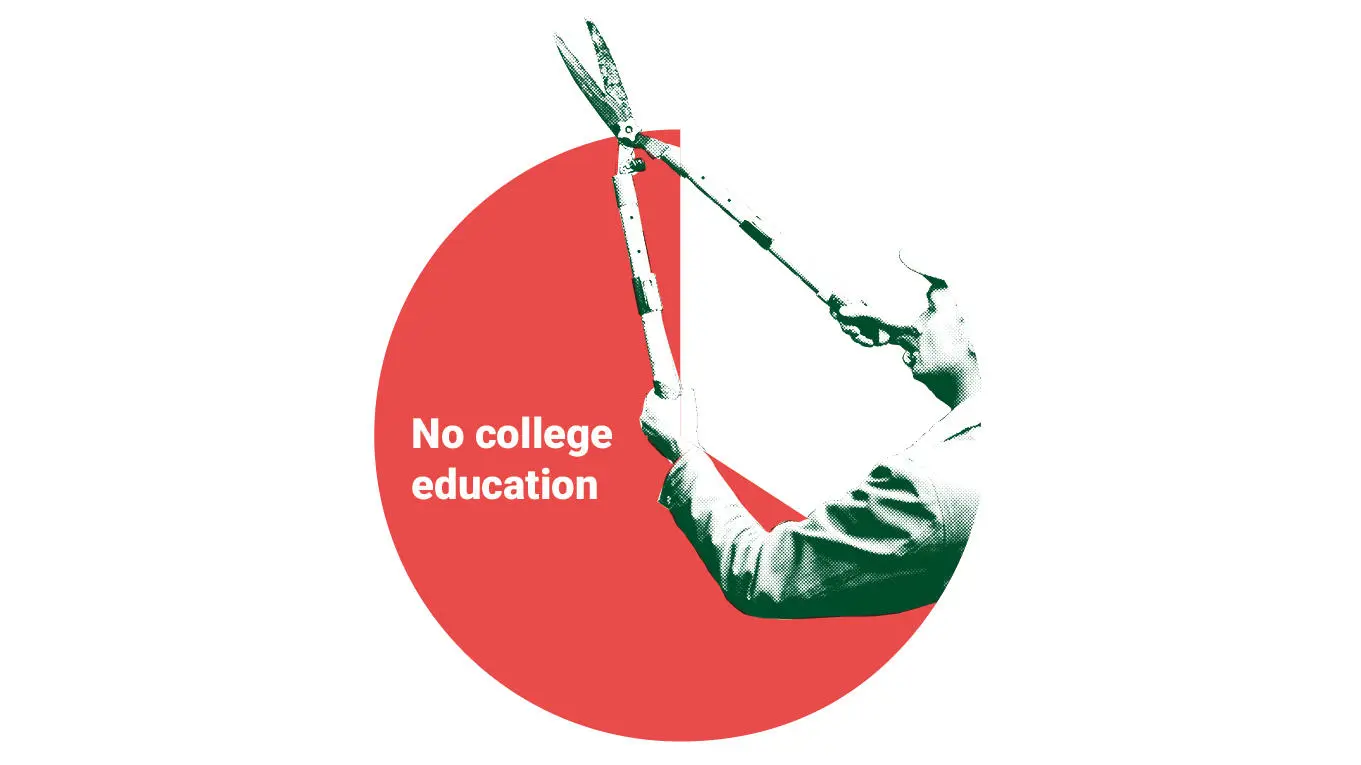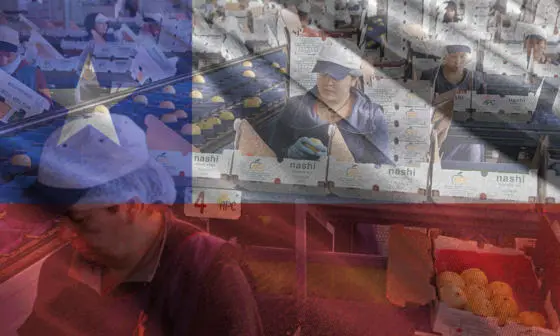Why low-skilled worker wages have stagnated even while the economy has thrived

Contents
- When a rise in productivity does not mean a rise in income
- Why aren’t productive workers being "rewarded" with wage rises?
- Slow productivity growth across high-skilled sectors means slower wage growth for less-skilled workers
- Innovation in high-skilled sectors will help increase low-skilled worker wages
"For many years as a growth economist I thought that economic growth was good for everyone – where there’s growth, it will trickle down to the whole country. But sadly, for low-skilled workers, especially those who have only finished high school, we see this isn’t true. In fact, since the 1980s, their wages have hardly grown at all."
Professor Rachel Ngai is explaining her recent research, which explores why low-skilled worker wages have stagnated, even as the industries that employ them have enjoyed a period of growth. Wages have flatlined so much for the United States, she highlights, that although labour productivity in the economy has increased by 60 percentage points since the 1980s, by 2010, wages for low-skilled workers were still only 20 percentage points above where they were 30 years previously. A similar pattern can be observed when we look at the UK.
This becomes even more puzzling when you consider that many of these jobs are traditionally in sectors that have experienced very fast productivity growth, while areas that have seen wage increases have often not seen the same dramatic changes in output.
When a rise in productivity does not mean a rise in income
Real wages have not grown for low-skilled workers in many years… Many sectors, however, have done well over this time.
"Sectors that employ high numbers of low-skilled workers, such as manufacturing and agriculture have very high productivity growth and yet wages of low-skilled workers lag far behind the aggregate productivity growth and wages of the high-skilled workers," Professor Ngai says.
"By comparison, sectors that employ a high number of high-skilled workers, such as education, have very low productivity growth – the way we teach is not so different from how we taught 100 years ago – and yet wages for high-skilled workers in education have grown far more. It’s puzzling, so I wanted to understand why this economic growth was not translating into wage rises for the many working in these high-productivity growth industries."
This is important, Professor Ngai stresses, as these workers make up the majority of the labour force. Data shows that, on average between 1980 and 2010, more than two thirds of the US labour force does not have a college degree, meaning that the majority of the workforce are living off wages that have not kept up with rising living costs.
Why aren’t productive workers being "rewarded" with wage rises?
To understand why this stagnation was occurring, Professor Ngai examined the product wages of low-skilled workers, and the productivity growths of the industries employing them.
"There are various ways we can look at wages," she explains. "There is a person’s nominal wage, which is what they are paid. But we learn more when we consider what that figure means for people’s ability to live - how far their pay goes when compared to the cost of living - and that is what we call their ‘real wage’.
"Knowing what the real wage is helps us measure the welfare of the worker. What we see is that real wages have not grown for low-skilled workers in many years, and that this is similar across industries. Many sectors, however, have done well over this time. It was when I looked at the product wage of these low-skilled workers across sectors that I started to understand why their wages have stagnated, even in periods of economic growth."

A person’s product wage is calculated by taking their salary and dividing it by the price of the goods they produce. In a world with many different products, the product wage is a measure of productivity of the worker, while the real wage is only a measure of purchasing power for the worker. Although the real wage grew very little for low-skilled workers across all sectors, when product wages are considered, a vastly different picture is revealed.
"Similar growth of real wage across sectors implies that the product wage of low-skilled workers is growing much faster in a manufacturing firm than in a hospital, because the relative price of the hospital service is rising," Professor Ngai explains. "My analysis revealed that the reason the real wage of low-skilled worker has grown so little is because they are moving away from sectors where their product wage is growing fast to ones with a slower productivity growth."
If you can create more high-skilled workers, supply and demand will help improve the relative wage of the low-skilled workers.
Slow productivity growth across high-skilled sectors means slower wage growth for less-skilled workers
Low-skilled workers have not benefitted, Professor Ngai’s analysis reveals, because many have moved sector, from the sectors that have experienced faster productivity growth to those that are more highly skilled, but with slower productivity growth.
"The productivity growth of different sectors varies hugely" she explains. "To take manufacturing and hospitals as an example, the price of healthcare has increased around the world much more than the price of a car. This is because technology has vastly sped up our ability to produce cars quickly, leading to a fall in price. At the same time, these advances mean that fewer jobs are needed to maintain a healthy output.
"High-skilled sector roles such as healthcare on the other hand, have not experienced the same productivity growth. However, every one of us as a consumer needs these services, and so we need more people working in hospitals than the factory.
"Now a low-skilled worker will earn say £20,000 whether they work in a factory or as a cleaner in a hospital - they go where the jobs are. So what we found is a migration of low-skilled workers away from sectors that would traditionally employ them, to more high-skilled areas that now need them. In fact, we now see more low-skilled workers working in these high-skill sectors. Unfortunately, their roles within these sectors are seen as less essential and not viewed as highly."
It is this reallocation, driven by changing relative prices, that is responsible for decades of wage stagnation, Professor Ngai argues: "Of course every hospital needs cleaners, but their place within the healthcare ecosystem is considered far less valuable than that of a doctor or a nurse, and so when pay is increased, it is these more skilled positions which benefit. That is the key essence of why we think this kind of reallocation can generate low-skill wage stagnation, even though the whole economy may be growing healthily."
Innovation in high-skilled sectors will help increase low-skilled worker wages
Professor Ngai identifies two ways this could be solved. One requires improving the productivity growth of the high-skilled sector, she argues. "This would allow us to slow down the rise in the relative price of the high-skilled services. If innovation can go into making them less expensive and more efficient that would be good news for the low-skilled worker."
The second way policymakers could look to improve wages for low-skilled workers is through education. "If you can create more high-skilled workers" she argues, "then supply and demand will help improve the relative wage of the low-skilled workers. If high-skilled workers become less scarce, the low-skilled worker can benefit. And then of course there is the direct benefit to the individual who is no longer a low-skilled worker but who can seek higher paid employment."
These two policy directions could help turn the tide on low-skilled worker wage-stagnation, Professor Ngai believes. Something that will only become more urgent to address as the impacts of the pandemic make life even more difficult for those on the lowest of wages.
Images: Unsplash and Pexels.
Dr Rachel Ngai was speaking to Jess Winterstein, Deputy Head of Media Relations at LSE.
Download a PDF version of this article




